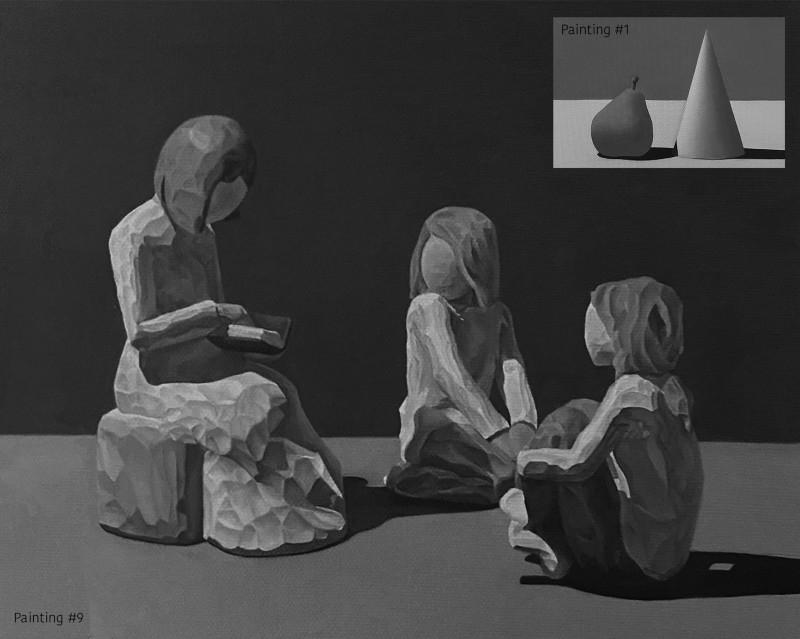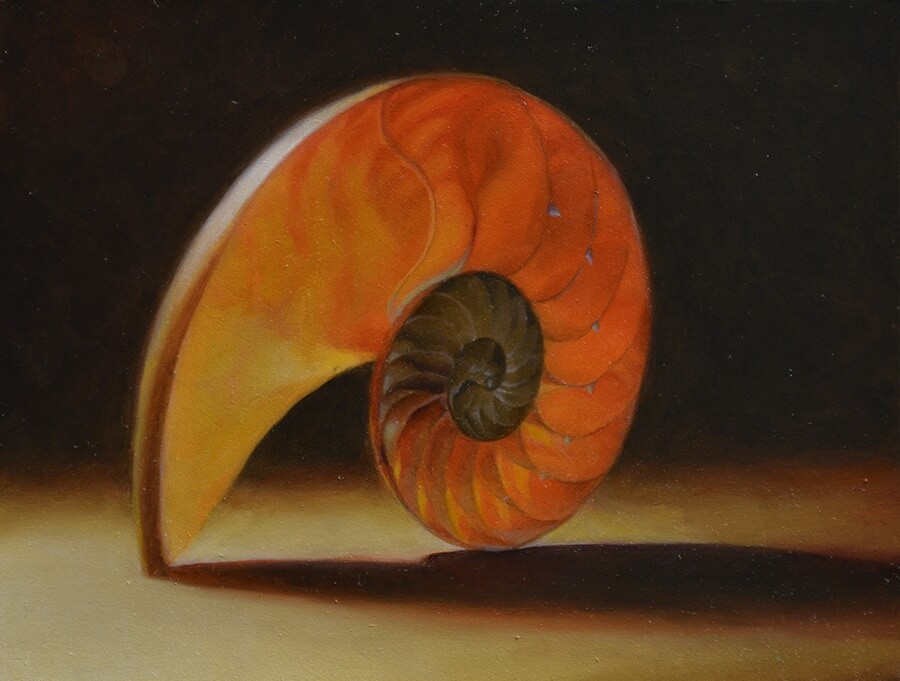
There’s a lot going on when you start painting. But by following these Evolve tips, you can avoid common painting mistakes!
More...
At the start of any art journey, there’s a lot going on! But with a few guiding tips, you can avoid several commonly made beginner painting mistakes!
These missteps, though common, often get overlooked by new painters and can lead to issues in their work down the road.
Through experience, many of these mistakes will eventually disappear over time and through the process of making paintings. However, understanding and looking for these common mistakes in your work now can help you to grow and improve as an artist.
So here are a few common beginner painting mistakes to keep an eye on and how they can be avoided!

Evolve student Brian C. shows a great example of perfectly controlled values. Can you see how all of the shadows are darker than even the darkest lights? This organization helps beginners to avoid common mistakes and understand how to handle value.
Beginner Painting Mistakes #1. Incorrect Values
Here at Evolve, we believe that value is one of the three moving parts of any painting. Value simply speaks about the lightness or darkness of tones and colors. Issues in value are a common mistake in beginner paintings.
One of the biggest value issues that surface in beginner work is the confusion of light and shadow. Evolve students learn how to paint within a strict set of rules. They receive only two light values and two shadow values to work with. These restrictions help them to learn that light and shadow values must be different at first. This is what creates the illusion of realism and reality in their work.
Value is a crucial part of any painting. Beginners must carefully examine their references and ensure that they understand what is light and shadow. By understanding this, they can place lights and shadows in the correct places with confidence, and without confusing the two, creating paintings that have a grounded, realistic feel to them.

These paintings by Evolve Student and instructor Karen B. are a good example of how simplicity leads to mastery. The first painting is her first painting from direct observation, and the second her last. By slowly progressing in the complexity of her paintings, she is confident in the measuring process.
Beginner Painting Mistakes #2. Choosing the Wrong Thing to Paint
One of the most common mistakes that beginners make is choosing an inappropriate subject for their level.
When you begin to learn how to oil paint, there are a lot of new concepts and rules to juggle. Challenging yourself with a complex still life or subject matter may improve your skills down the road. However, as a beginner, keep it simple.
Often, we tell our students that when setting up a still life, simple objects can be made complex by arranging them in a complex manner. This prevents students from choosing too difficult a subject to complete or that causes them to develop bad habits.
When students paint objects that are too complex for what they can currently do, the foundations of their art shake. Some things become slightly generalized and shortcuts are taken simply because the subject matter is difficult.
As a beginner, you want to feel slightly challenged but have no doubts that you can successfully and accurately paint the object in front of you. If you have any doubts or are unsure of how to approach something, chances are it’s too complex at the moment.

Evolve students learn how to mix rich colors using Old Holland Paint
Beginner Painting Mistakes #3. Color Mixtures and Overusing White
Color mixing holds an important place in learning how to paint. However, one of the common beginner painting mistakes is to not experiment with color mixtures, but instead to use paint directly from the tube.
Now a few, beautiful colors can be used straight out of the tube, but this is very rare! A large part of painting happens in the color mixing stage before you even touch the canvas. This means that students must practice and experiment with color mixtures.
Much of this lies in only accepting the highest quality for your work. So if it is in your ability to make a color perfect, do so. If you cannot figure out a color and have experimented as much as you know how then get as close as possible and trust that with each painting the color mixing will improve if you are holding yourself to high standards.
Along with failing to properly mix color, many students overuse white in their paintings to lighten their mixtures. White is a necessary color to lighten and create certain paint mixtures, but when overused, can destroy a painting.
White paint tends to pull the color out of paint mixtures. So if you add too much white to a mixture, you may end up with an unsaturated, less colorful version of your desired color.
To avoid overusing white, simply experiment with adding other light colors instead of relying solely on white. By carefully thinking through your mixtures and practicing, you can avoid many common mistakes in color mixing.

An example of colorful shadows by Evolve Student Tiffany B.
Beginner Painting Mistakes #4. Using Only Black for Shadows
Using pure black in the place of a shadow is the final of the beginner painting mistakes we will discuss.
Shadows provide crucial information for paintings, explaining the direction, intensity, and temperature of the light.
Many students rely heavily on black for making shadows. They will simply use pure black or brown for their shadows, with no color or variation. This creates flat, unrealistic shadows, whereas true shadows have an enormous amount of color and life in them.
Here at Evolve, we teach our students to create a light mixture and then add black to it to express a shadow in the beginning. This helps keep things simple at first. As they master color light mixing, we transition them into mixing color shadows, mixing exactly the color they see in the shadow and applying it to their painting.
Reflections also play a large part in realistic shadows. However, many beginners make the mistake of leaving them out or overstating them. Leaving out a reflection means leaving out vital information about the light and object. Making a reflection in the shadows as bright as a light value means that it will no longer read as a shadow but as light. Both mistakes can cause a painting to fall short of its potential.
Taking care to examine the color and value of a shadow means that you will avoid the beginner painting mistakes of painting shadows flat black.

Guidance from a quality teacher will help you to avoid most mistakes, if you want to learn more, visit us at Evolve Artist.
Conclusion
Making mistakes is a part of learning. But if you do not learn or grow from your beginner painting missteps, they are then truly mistakes that will stick with you. By looking for these common issues in your paintings as you learn, you will continue to improve and spot them for yourself.
If you keep high standards for your work and continue to learn from your mistakes, you will grow exponentially as an artist.
FREE MASTERCLASS:
The 4 Part Framework to Develop Artistic Excellence in 12 Months
